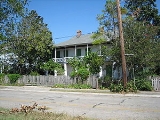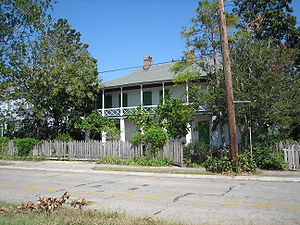
Pitot House
Encyclopedia
The Pitot House is a historic landmark
in New Orleans
, and is listed on the National Register of Historic Places
.
 The Pitot House is an 18th century Creole
The Pitot House is an 18th century Creole
colonial
plantation
home located at 1440 Moss Street in New Orleans, Louisiana
. The Pitot House is currently owned by the Louisiana Landmark Society, which uses the building as its headquarters
. The house is situated on Bayou St. John
and was moved several blocks from its original site in order to prevent its demolition.
' great-grandmother, the ground floor was enclosed with masonry walls of soft brick. Rillieux was also responsible for adding the southern gallery
and several outbuildings, which are no longer extant. The house is named after James Pitot
, the fourth owner of the house who resided there from 1810 to 1819. James is considered to be the first "American" Mayor
of New Orleans, for although he was a native of France
, he became a naturalized American citizen before arriving in New Orleans in 1796. Inside are American and Louisiana antiques from the early 19th century, but the antiques are not original to the home. A portrait of Sophie Gabrielle, James Pitot's daughter, is the only artifact owned by any past resident of the house. Other notable owners of the house include Felix Ducayet and Mother Cabrini
, America's first named saint
.
s.
The Pitot House was also designed to withstand floods and was able to survive the floods of Hurricane Katrina
due to brick floors on the bottom level of the house which would have originally been caulked with a dry mix of sand and lime, allowing flood waters to drain through. The gallery, back loggia
, and sleeping porch
were used for outdoor entertaining, dining, and sleeping; they were fitted with shutters to provide relief from the intense Louisiana sun.
, indigo
, cotton
, herbs, and vegetables. The garden is a traditional parterre garden, designed to be viewed from the above gallery. Next to the house is a 10000 square feet (929 m²) yard, where parties and events are held.
Landmark
This is a list of landmarks around the world.Landmarks may be split into two categories - natural phenomena and man-made features, like buildings, bridges, statues, public squares and so forth...
in New Orleans
New Orleans, Louisiana
New Orleans is a major United States port and the largest city and metropolitan area in the state of Louisiana. The New Orleans metropolitan area has a population of 1,235,650 as of 2009, the 46th largest in the USA. The New Orleans – Metairie – Bogalusa combined statistical area has a population...
, and is listed on the National Register of Historic Places
National Register of Historic Places
The National Register of Historic Places is the United States government's official list of districts, sites, buildings, structures, and objects deemed worthy of preservation...
.

Louisiana Creole people
Louisiana Creole people refers to those who are descended from the colonial settlers in Louisiana, especially those of French and Spanish descent. The term was first used during colonial times by the settlers to refer to those who were born in the colony, as opposed to those born in the Old World...
colonial
Colonialism
Colonialism is the establishment, maintenance, acquisition and expansion of colonies in one territory by people from another territory. It is a process whereby the metropole claims sovereignty over the colony and the social structure, government, and economics of the colony are changed by...
plantation
Plantation
A plantation is a long artificially established forest, farm or estate, where crops are grown for sale, often in distant markets rather than for local on-site consumption...
home located at 1440 Moss Street in New Orleans, Louisiana
Louisiana
Louisiana is a state located in the southern region of the United States of America. Its capital is Baton Rouge and largest city is New Orleans. Louisiana is the only state in the U.S. with political subdivisions termed parishes, which are local governments equivalent to counties...
. The Pitot House is currently owned by the Louisiana Landmark Society, which uses the building as its headquarters
Headquarters
Headquarters denotes the location where most, if not all, of the important functions of an organization are coordinated. In the United States, the corporate headquarters represents the entity at the center or the top of a corporation taking full responsibility managing all business activities...
. The house is situated on Bayou St. John
Bayou St. John
Bayou St. John is a bayou within the city of New Orleans, Louisiana.The Bayou as a natural feature drained the swampy land of a good portion of what was to become New Orleans into Lake Pontchartrain...
and was moved several blocks from its original site in order to prevent its demolition.
History
The Pitot House was initially constructed in 1799 by Don Bartolome Bosque as a country retreat along Bayou St. John. It is speculated that Bosque's house was a raised cottage on brick pillars. It is also believed that during the ownership of Madame Rillieux (1805–1810), Edgar DegasEdgar Degas
Edgar Degas[p] , born Hilaire-Germain-Edgar De Gas, was a French artist famous for his work in painting, sculpture, printmaking and drawing. He is regarded as one of the founders of Impressionism although he rejected the term, and preferred to be called a realist...
' great-grandmother, the ground floor was enclosed with masonry walls of soft brick. Rillieux was also responsible for adding the southern gallery
Balcony
Balcony , a platform projecting from the wall of a building, supported by columns or console brackets, and enclosed with a balustrade.-Types:The traditional Maltese balcony is a wooden closed balcony projecting from a...
and several outbuildings, which are no longer extant. The house is named after James Pitot
James Pitot
James Pitot was the second Mayor of New Orleans.Born Jacques-François Pitot in Normandy and educated in Paris, Pitot's family was of the nobility of France, and fled that nation for the New World with the French Revolution. At first he settled in Philadelphia, where he became a USA citizen...
, the fourth owner of the house who resided there from 1810 to 1819. James is considered to be the first "American" Mayor
Mayor
In many countries, a Mayor is the highest ranking officer in the municipal government of a town or a large urban city....
of New Orleans, for although he was a native of France
France
The French Republic , The French Republic , The French Republic , (commonly known as France , is a unitary semi-presidential republic in Western Europe with several overseas territories and islands located on other continents and in the Indian, Pacific, and Atlantic oceans. Metropolitan France...
, he became a naturalized American citizen before arriving in New Orleans in 1796. Inside are American and Louisiana antiques from the early 19th century, but the antiques are not original to the home. A portrait of Sophie Gabrielle, James Pitot's daughter, is the only artifact owned by any past resident of the house. Other notable owners of the house include Felix Ducayet and Mother Cabrini
Mother Cabrini
Saint Francesca Xavier Cabrini, M.S.C., , also called Mother Cabrini, was the first citizen of the United States to be canonized by the Roman Catholic Church.-Early life:...
, America's first named saint
Saint
A saint is a holy person. In various religions, saints are people who are believed to have exceptional holiness.In Christian usage, "saint" refers to any believer who is "in Christ", and in whom Christ dwells, whether in heaven or in earth...
.
House
The house was saved from destruction by the Louisiana Landmarks Society in the 1960s and restored to its original splendor, showing the double-pitched hipped roof, and the plaster-covered brick-between-post construction. The wooden posts act as structural support, the brick offers thermal insulation, and the plaster protects this medley from dampness and rot. The style of the Pitot House is ensuite -- with no hallways and an outdoor stairway. The house was designed with hot summers and insects in mind. The doors were positioned across from each other to keep cool air moving. The extended galleries on both the bottom and top levels of the house keep the sun off the walls and offer outdoor breezewayBreezeway
A breezeway is an architectural feature similar to a hallway that allows the passage of a breeze between structures to accommodate high winds, allow aeration, or provide aesthetic design variation. Often a breezeway is a simple roof connecting two structures ; sometimes it can be much more like a...
s.
The Pitot House was also designed to withstand floods and was able to survive the floods of Hurricane Katrina
Hurricane Katrina
Hurricane Katrina of the 2005 Atlantic hurricane season was a powerful Atlantic hurricane. It is the costliest natural disaster, as well as one of the five deadliest hurricanes, in the history of the United States. Among recorded Atlantic hurricanes, it was the sixth strongest overall...
due to brick floors on the bottom level of the house which would have originally been caulked with a dry mix of sand and lime, allowing flood waters to drain through. The gallery, back loggia
Loggia
Loggia is the name given to an architectural feature, originally of Minoan design. They are often a gallery or corridor at ground level, sometimes higher, on the facade of a building and open to the air on one side, where it is supported by columns or pierced openings in the wall...
, and sleeping porch
Sleeping porch
A sleeping porch is a deck or balcony that is screened and furnished for sleeping in the warmer months. Sleeping porches can be on ground level or on a higher storey and in either the front or back of a home...
were used for outdoor entertaining, dining, and sleeping; they were fitted with shutters to provide relief from the intense Louisiana sun.
Garden
The garden at the Pitot House grows plants traditional to the time period when the Pitot House was built. These plants include indigenous flowers, citrus, sugar cane, tobaccoTobacco
Tobacco is an agricultural product processed from the leaves of plants in the genus Nicotiana. It can be consumed, used as a pesticide and, in the form of nicotine tartrate, used in some medicines...
, indigo
Indigo
Indigo is a color named after the purple dye derived from the plant Indigofera tinctoria and related species. The color is placed on the electromagnetic spectrum between about 420 and 450 nm in wavelength, placing it between blue and violet...
, cotton
Cotton
Cotton is a soft, fluffy staple fiber that grows in a boll, or protective capsule, around the seeds of cotton plants of the genus Gossypium. The fiber is almost pure cellulose. The botanical purpose of cotton fiber is to aid in seed dispersal....
, herbs, and vegetables. The garden is a traditional parterre garden, designed to be viewed from the above gallery. Next to the house is a 10000 square feet (929 m²) yard, where parties and events are held.

